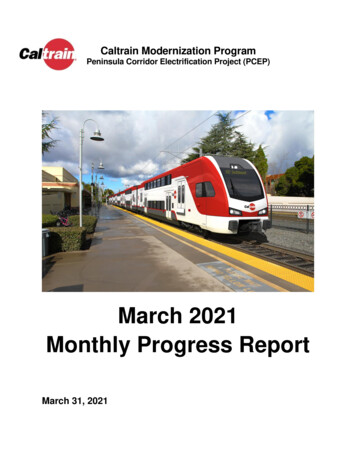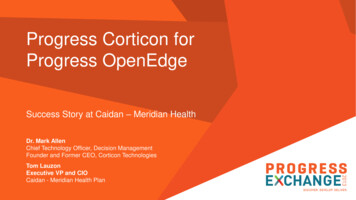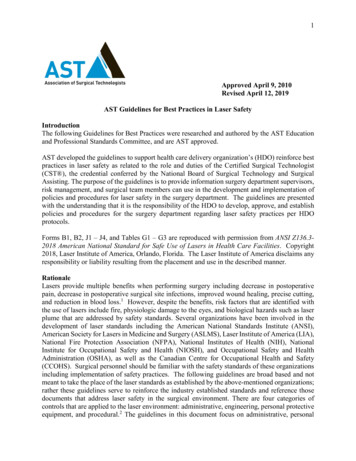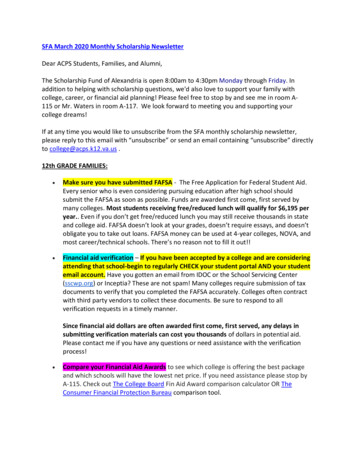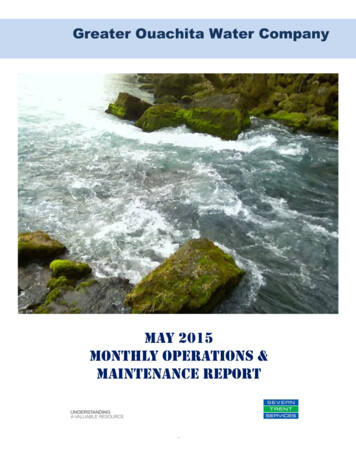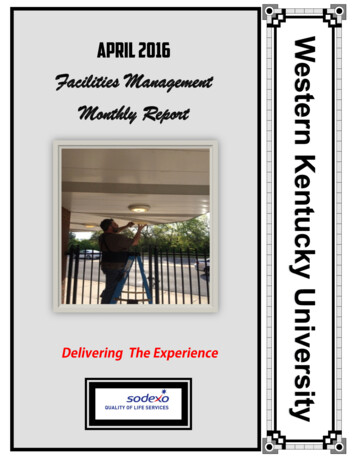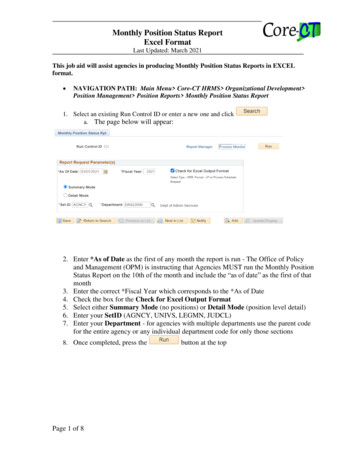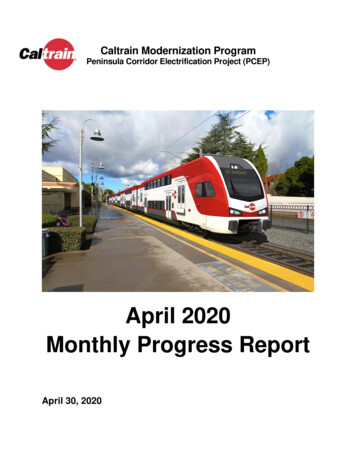
Transcription
Caltrain Modernization ProgramPeninsula Corridor Electrification Project (PCEP)April 2020Monthly Progress ReportApril 30, 2020
Funding PartnersFederal Transit Administration (FTA) Core CapacityFTA Section 5307 (Environmental / Pre Development only)FTA Section 5307 (Electric Multiple Unit (EMU) only)Prop 1B (Public Transportation Modernization & Improvement Account)Caltrain Low Carbon Transit Operations Cap and TradeProposition 1ACalifornia High Speed Rail Authority (CHSRA) Cap and TradeCarl Moyer FundBridge Tolls (Funds Regional Measure (RM) 1/RM2)San Francisco County Transportation Authority (SFCTA)/San FranciscoMunicipal Transportation Agency (SFMTA)San Mateo County Transportation Authority (SMCTA) ContributionSMCTA Measure ASanta Clara Valley Transportation Authority (VTA) Measure AVTA ContributionCity and County of San Francisco (CCSF) Contribution
THIS PAGE INTENTIONALLY LEFT BLANK
Peninsula Corridor Electrification ProjectMonthly Progress ReportTable of ContentsPage1.02.03.04.0Background . 1-1Executive Summary. 2-12.1.Monthly Dashboards . 2-22.2.Funding Partners Participation in PCEP . 2-52.3.Schedule . 2-82.4.Budget . 2-92.5.Board Actions . 2-102.6.Government and Community Affairs . 2-10Electrification – Infrastructure . 3-13.1.Electrification . 3-13.2.Supervisory Control and Data Acquisition . 3-33.3.Tunnel Modification . 3-4Electric Multiple Units . 4-14.1.Electric Multiple Units . 4-14.2.5.06.07.08.09.010.011.012.0Safety . 5-1Quality Assurance . 6-1Schedule . 7-1Budget and Expenditures . 8-1Change Management . 9-1Funding . 10-1Risk Management . 11-1Environmental . 12-112.1. Permits . 12-112.2.13.014.015.016.017.018.019.0Centralized Equipment Maintenance and Operations Facility Modifications . 4-1Mitigation Monitoring and Reporting Program (MMRP) . 12-1Utility Relocation . 13-1Real Estate . 14-1Third Party Agreements . 15-1Government and Community Affairs . 16-1Disadvantaged Business Enterprise (DBE) Participation and Labor Statistics . 17-1Procurement . 18-1Timeline of Major Project Accomplishments . 19-1Table of ContentsiApril 30, 2020
Peninsula Corridor Electrification ProjectMonthly Progress ReportList of TablesPageTable 2-1 Schedule Status . 2-9Table 2-2 Budget and Expenditure Status . 2-10Table 3-1 Work Progress by Segment . 3-1Table 6-1 Quality Assurance Audit Summary . 6-2Table 7-1 Schedule Status . 7-1Table 7-2 Critical Path Summary . 7-2Table 7-3 Schedule Hold Points . 7-2Table 8-1 Electrification Budget & Expenditure Status . 8-1Table 8-2 EMU Budget & Expenditure Status . 8-2Table 8-3 PCEP Budget & Expenditure Status . 8-2Table 8-4 Third Party Improvements/CNPA Budget & Expenditure Status . 8-2Table 8-5 Budget Transfers of Contingency . 8-3Table 15-1 Third-Party Agreement Status . 15-1List of FiguresPageFigure 2-1 PCEP Work Segments . 2-1Figure 2-2 Expenditure – Planned vs. Actual . 2-2Figure 2-3 Spending Rate vs Required . 2-3Figure 2-4 Construction Contract Budgets . 2-3Figure 2-5 OCS Foundation Production . 2-4Figure 2-6 Contractor Completion Schedule . 2-4Figure 10-1 Funding Plan . 10-1Figure 11-1 Monthly Status of Risks. 11-2Figure 11-2 Risk Classification . 11-3Figure 17-1 DBE Participation . 17-1List of AppendicesPageAppendix A – Acronyms . A-1Appendix B – Funding Partner Meetings . B-1Appendix C – Schedule. C-1Appendix D – Standard Cost Codes. D-1Appendix E – Change Order Logs. E-1Appendix F – Risk Table . F-1Appendix G – MMRP Status Log .G-1Table of ContentsiiApril 30, 2020
Peninsula Corridor Electrification ProjectMonthly Progress Report1.0BACKGROUNDOver the last decade, Caltrain has experienced a substantial increase in ridership andanticipates further increases in ridership demand as the San Francisco Bay Area’spopulation grows. The Caltrain Modernization (CalMod) Program, scheduled to beimplemented by 2021, will electrify and upgrade the performance, operating efficiency,capacity, safety, and reliability of Caltrain’s commuter rail service.The PCEP is a key component of the CalMod Program and consists of convertingCaltrain from diesel-hauled to Electric Multiple Unit (EMU) trains for service between theSan Francisco Station (at the intersection of Fourth and King Streets in San Francisco)and the Tamien Station in San Jose. Caltrain will continue Gilroy service and supportexisting tenants.An electrified Caltrain will better address Peninsula commuters’ vision of environmentallyfriendly, fast and reliable service. Electrification will modernize Caltrain and make itpossible to increase service while offering several advantages in comparison withexisting diesel power use, including: Improved Train Performance, Increased Ridership Capacity and IncreasedService: Electrified trains can accelerate and decelerate more quickly than dieselpowered trains, allowing Caltrain to run more efficiently. In addition, because oftheir performance advantages, electrified trains will enable more frequent and/orfaster train service to more riders. Increased Revenue and Reduced Fuel Cost: An electrified Caltrain will increaseridership and fare revenues while decreasing fuel costs. Reduced Engine Noise Emanating from Trains: Noise from electrified trainengines is measurably less than noise from diesel train engines. Train horns willcontinue to be required at grade crossings, adhering to current safety regulations. Improved Regional Air Quality and Reduced Greenhouse Gas Emissions:Electrified trains will produce substantially less corridor air pollution compared withdiesel trains even when the indirect emissions from electrical power generation areincluded. Increased ridership will reduce automobile usage, resulting in additionalair quality benefits. In addition, the reduction of greenhouse gas emissions willimprove our regional air quality, and will also help meet the state’s emissionreduction goals.Background1-1April 30, 2020
THIS PAGE INTENTIONALLY LEFT BLANK
Peninsula Corridor Electrification ProjectMonthly Progress Report2.0EXECUTIVE SUMMARYThe Monthly Progress Report is intended to provide an overview of the PCEP andprovide funding partners, stakeholders, and the public an overall update on the progressof the project. This document provides information on the scope, cost, funding, schedule,and project implementation. Work along the Caltrain Electrification Corridor has beendivided into four work segments and respective work areas (WA) as shown in Figure 2-1.PCEP activities are described and summarized by segments and work areas.Figure 2-1 PCEP Work SegmentsExecutive Summary2-1April 30, 2020
Peninsula Corridor Electrification ProjectMonthly Progress ReportOn- and off-track foundations were installed and feeder and static wires were strung inSegment 3 for the Overhead Catenary System (OCS). The contractor, Balfour BeattyInfrastructure, Inc. (BBII), and PCEP staff strategized how to take better advantage ofthe additional work windows created by the reduction in service as a result of the shelterin-place order due to Coronavirus Disease 2019 (COVID-19). A total of 128 foundationswere installed this month. BBII intends to complete foundation installation by the end ofthis year. In addition, two signal houses were installed, as well as overhead bridgeattachments at various locations in Segments 2 and 3.The effects of COVID-19 on EMU production have not changed. Production inSwitzerland is near normal and shell and frame shipments are on schedule with 33shells total shipped, 28 of which are on site at Stadler’s Salt Lake City facility. Thetesting of Trainset No. 1 is still on hold pending the lifting of travel restrictions for testingpersonnel. Supply chains are still challenged to meet demands.The tunnel shutdowns for the Tunnel Modification Project are complete, and workcontinues during this shelter-in-place period. Fencing and conductor rail installationwere completed this month, and other work is ongoing.The Centralized Equipment Maintenance and Operations Facility (CEMOF) workfocused largely on the parts storage warehouse, where progress was made to begin thefoundation for the structure.2.1.Monthly DashboardsDashboard progress charts are included below to summarize construction progress.Figure 2-2 Expenditure – Planned vs. ActualExecutive Summary2-2April 30, 2020
Peninsula Corridor Electrification ProjectMonthly Progress ReportFigure 2-3 Spending Rate vs. RequiredFigure 2-4 Construction Contract BudgetsExecutive Summary2-3April 30, 2020
Peninsula Corridor Electrification ProjectMonthly Progress ReportFigure 2-5 OCS Foundation ProductionFigure 2-6 Contractor Completion ScheduleExecutive Summary2-4April 30, 2020
Peninsula Corridor Electrification ProjectMonthly Progress Report2.2.Funding Partners Participation in PCEPThe PCEP has a series of weekly, biweekly, monthly and quarterly meetings tocoordinate all aspects of the program. The meetings are attended by project staff withparticipation by our funding partners in accordance with the Funding Partners OversightProtocol. A summary of funding partner meetings and invitees can be found inAppendix B.This section of the report provides a summary of the discussions and decisions made atthe meetings and a list of funding partners who attended the meetings.Electrification – Weekly Discipline-Specific MeetingsPurpose: To replace the previous weekly Engineering Meeting with three disciplinespecific meetings for the three major categories of work under the Electrification DesignBuild (DB) contract: Overhead Contact System (OCS) Foundation, Traction PowerFacilities (TPF), and Signals. Each meeting will focus on the status, resolution andtracking of Balfour Beatty Infrastructure, Inc. (BBII) and Electrification design- andconstruction-related issues.Activity this MonthOCS Foundation MeetingFunding Partners: None Review of upcoming foundation design and installation schedule Discussion of open issues impacting foundations design and installation Discussion of outstanding Requests for Information (RFI) Review of foundation designs that potentially impact Right of Way (ROW) Review of outstanding Field Orders or Change Notices required for work tocontinueTPF MeetingFunding Partners: None Review of outstanding items as they relate to the design and construction of thePG&E Interconnection Review of status of long-lead material procurement Review of PG&E Interconnection schedule Discuss progress and next steps for the Single Phase Study Discuss outstanding comments on the interconnection agreement Review and resolve open issues on the construction and design of the TPFs(paralleling stations, traction power substations, switching station)Executive Summary2-5April 30, 2020
Peninsula Corridor Electrification ProjectMonthly Progress ReportSignal MeetingFunding Partners: None Discussion of design, installation and testing of the signal and communicationmodifications to the Caltrain system Discussion of outstanding comments and responses to comments on signal andcommunication design packages Review of schedule for signal and communication cutover plans Discuss and resolve RFIsPCEP Delivery Coordination Meeting – Bi-WeeklyPurpose: To facilitate high-level coordination and information sharing between crossfunctional groups regarding the status of the work for which they are responsible.Activity this MonthFunding Partners: VTA: Edwin Castillo; SFCTA: Luis ZurinagaThe JPB has received concurrence from the San Francisco City Administrator and CityHealth Director for the PCEP essential project designation, allowing construction work tocontinue. In environmental and planning, a Western Burrowing Owl and a CoopersHawk nest were found as part of the ongoing surveys. The project is complying with thedistance needed to protect this wildlife while conducting work and is continuallymonitoring for any disturbed behavior. In contracts and procurement, two sole-sourcecontract amendments, On-Call Program Management Support Services and On-CallElectrification Support Services, are projected to go to the June JPB Board meeting.The Caltrain On-Track Safety Rules (OTS) revision will be effective April 20, and trainingfor the contractor was conducted in mid-April. For EMU design and manufacturing, truckframes and carshells production are on schedule. Salt Lake City (SLC) testing andcommissioning of Trainset 1 is on hold due to Coronavirus Disease 2019 (COVID-19)travel restrictions, and the shipment of Trainset 1 to Pueblo is now scheduled forOctober 1. The two-person table test was conducted on April 20 with encouragingresults. The Stadler SLC activities and facilities received a satisfactory report from theProject Management Oversight Consultant (PMOC) visit on April 13. In design buildactivities, foundation work has restarted in Segment (S) S3 with on-tracking through April20 and off-tracking on April 22. BBII projects 140 foundations to be completed by theend of the month with a target completion for all foundations at the end of the year.Installation of poles and assemblies continue in S4 and S3, and Overhead CatenarySystem (OCS) wiring is ongoing in S4. Utility coordination of corridor-wide relocations isbeing monitored for any impacts due to COVID-19. The pre-Factory Acceptance Test(FAT) for the Supervisory Control and Data Acquisition (SCADA) has commenced.Executive Summary2-6April 30, 2020
Peninsula Corridor Electrification ProjectMonthly Progress ReportSystems Integration Meeting – Bi-WeeklyPurpose: To discuss and resolve issues with inter-system interfaces and to identify andassign Action Item Owners for interface points that have yet to be addressed.Activity this MonthFunding Partners: NoneBi-weekly PCEP interface meetings are held to monitor and determine appropriateresolution for systems integration issues. All information from the systems integrationdatabase was recovered, is now in an Excel spreadsheet and individual items are beingupdated. The Action Items spreadsheet is the primary tracking method while review andSystem Integration matrix updates are in progress. The electrification contractor now hasa representative invited to attend the Bi-Weekly Systems Integration Meeting. TheSystems Integration Lead also maintains contact with the EMU procurement team. TheTraction Power SCADA team also holds bi-weekly status meetings. Coordination withthe EMU procurement, PTC and Caltrain Capital Project managers responsible fordelivery of the 25th Avenue Grade Separation Project, Marin Napoleon BridgeRehabilitation Project, and the South San Francisco Station Project is ongoing. There iscoordination with the Tunnel Modification Project and the CEMOF upgrades as well.Progress on activities including systems integration testing activ
Peninsula Corridor Electrification Project Monthly Progress Report Table of Contents i April 30, 2020 . tracking of Balfour Beatty Infrastructure, Inc. (BBII) and Electrification design- and . For EMU design and manufacturing,
